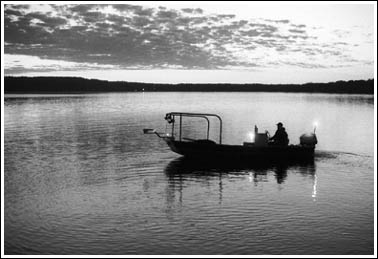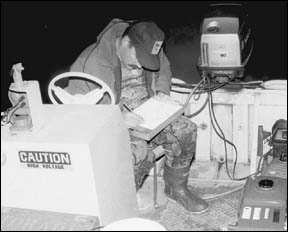DNR samples walleyes through electrofishing
This article submitted by Michael Jacobson on 10/18/00.
 Rice and Koronis are two of six area lakes where the Department of Natural Resources relies on natural reproduction of walleyes.
Rice and Koronis are two of six area lakes where the Department of Natural Resources relies on natural reproduction of walleyes.
"Every fall we do this electrofishing to determine the natural production," said Dave Coahran, DNR Fisheries Specialist.
When the water temperature drops to the low 60s or high 50s, DNR staffers head out at night to check the number of young walleyes. At those temperatures, the current year's crop of walleyes is in feeding as much as it can to prepare for their first winter. This makes them susceptible to sampling, Coahran said.
The DNR tests by using a boat with enough gadgets to make any fisherman jealous. The boat uses a 5,000-watt generator. The resulting AC current is switched into pulse DC current, which is less harmful to the fish.
The pulse is transmitted by a sphere in the front of the boat. The effective range is six to eight feet deep and ten to 15 feet to the sides, depending on the water's conductiveness. "The fish cannot help themselves," explained Coahran. "They swim to the sphere, and when they get close enough they get shocked."
The fish are stunned, netted, measured and weighed, and stored in a live well.
The fish fully recover in a few minutes, Coahran said.
The DNR surveys on Rice and Koronis are done by Barry Flanders (pictured at left putting walleye yearlings in a holding tank) and Brad Carlson, who both work for DNR Fisheries in Spicer and live in Paynesville. They conducted the survey on Koronis on Wednesday, Sept. 27, and Rice on Wednesday, Oct. 11.
On Koronis, they surveyed six areas: five along shore and one by the islands. Each year they survey the same spots for comparison purposes.
 The results this year were 30 fish per hour, which Coahran said was just okay. Their previous results (young of the year walleyes per hour) were 24 in 1999, three in 1998, 82 in 1997, 27 in 1996, 61 in 1995, 11 in 1994, and 38 in 1993. The DNR considers the 1998 survey to be not a good representation because the water temperature was colder than normal.
The results this year were 30 fish per hour, which Coahran said was just okay. Their previous results (young of the year walleyes per hour) were 24 in 1999, three in 1998, 82 in 1997, 27 in 1996, 61 in 1995, 11 in 1994, and 38 in 1993. The DNR considers the 1998 survey to be not a good representation because the water temperature was colder than normal.
The Rice Lake results were 32 per hour, which is a moderate level for the lake. The previous results for Rice were 9.3 in 1999, 16 in 1998, 90 in 1997, 84 in 1996, 141 in 1995, 18 in 1994, and 63 in 1993.
Bruce Gilbertson, area fisheries manager, said the results were encouraging for Rice this year. "Overall, the abundance of walleyes is very good on Rice," Gilbertson commented. Of lakes similar to Rice, it falls in the top three-quarters of such lakes.
The fall electrofishing was started in the fall of 1993 as a tool to determine the natural reproduction of a lake. These results are then used by the DNR to determine if any stocking needs to be done. When natural reproduction suffers two straight down years, the DNR would consider stocking, according to Coahran.
The DNR does stock some lakes yearly. Long Lake is stocked regularly with fingerlings.
 In fact, one of their prime rearing ponds for fingerlings is Lake Henry. The DNR uses lakes that have a hard winter kill to eliminate predators while rearing the fingerlings.
In fact, one of their prime rearing ponds for fingerlings is Lake Henry. The DNR uses lakes that have a hard winter kill to eliminate predators while rearing the fingerlings.
Brad Carlson drives the boat during the sampling. After the yearlings are in the holding tank, he records the numbers for each site.
The DNR would prefer to stock lakes with fry, Coahran said, because millions of fry can be used instead of thousands of fingerlings. However, on clear lakes, fry are too vulnerable to predators and would be decimated.
Large, deep lakes, like Koronis and Rice, have so much natural reproduction that the DNR's contributions through stocking were minimal. Coahran estimated that their stocking contributed at most ten percent to the production of walleyes on deep lakes.
The last time Koronis received a major stocking of walleye fingerlings was in 1993.
This year, as a result of the electrofishing survey, low reproduction of walleyes in Green Lake was identified for the fourth year in a row. So, the DNR plans to stock the lake with 2,054 pounds of fingerlings.
The other area lakes where the DNR relies on natural reproduction are Nest, Norway, and Diamond.
The DNR also uses gill nets every few years to catch and survey walleyes. In 1999, they averaged 8.7 per net; in 1997, 22 per net; and in 1994, 11.3.
"It maintains itself real well without any stocking," said Coahran.
Return to Archives
 The results this year were 30 fish per hour, which Coahran said was just okay. Their previous results (young of the year walleyes per hour) were 24 in 1999, three in 1998, 82 in 1997, 27 in 1996, 61 in 1995, 11 in 1994, and 38 in 1993. The DNR considers the 1998 survey to be not a good representation because the water temperature was colder than normal.
The results this year were 30 fish per hour, which Coahran said was just okay. Their previous results (young of the year walleyes per hour) were 24 in 1999, three in 1998, 82 in 1997, 27 in 1996, 61 in 1995, 11 in 1994, and 38 in 1993. The DNR considers the 1998 survey to be not a good representation because the water temperature was colder than normal. Rice and Koronis are two of six area lakes where the Department of Natural Resources relies on natural reproduction of walleyes.
Rice and Koronis are two of six area lakes where the Department of Natural Resources relies on natural reproduction of walleyes.  In fact, one of their prime rearing ponds for fingerlings is Lake Henry. The DNR uses lakes that have a hard winter kill to eliminate predators while rearing the fingerlings.
In fact, one of their prime rearing ponds for fingerlings is Lake Henry. The DNR uses lakes that have a hard winter kill to eliminate predators while rearing the fingerlings.